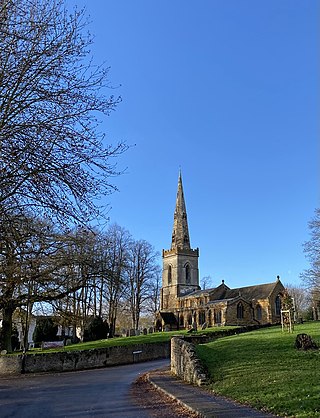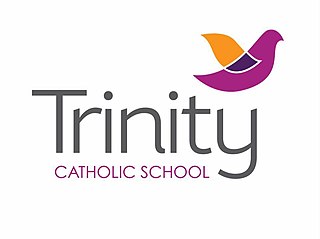
Northampton is a market town and civil parish in the East Midlands of England, on the River Nene, 60 miles (97 km) north-west of London and 50 miles (80 km) south-east of Birmingham. It is the historic county town of Northamptonshire, but since local government changes in 2021, it has been the administrative centre of the unitary authority of West Northamptonshire. Northampton is one of the largest towns in England; In the 2021 census its urban area had a population of 245,899, increased from 215,273 at the 2011 census.

Kettering is a market and industrial town in North Northamptonshire, England. It is located 67 miles (108 km) north of London and 15 miles (24 km) north-east of Northampton, west of the River Ise, a tributary of the River Nene. The name means "the place of Ketter's people ".

Kingsthorpe is a suburb and civil parish of Northampton, England. It is situated to the north of Northampton town centre and is served by the A508 and A5199 roads which join at Kingsthorpe's centre. The 2011 Census recorded the population of the district council ward as 4,477.

Campion School is a co-educational secondary school in Bugbrooke, about 6 miles (10 km) from Northampton, Northamptonshire. Founded in 1969, it became a Language College in September 1997, and in 2011 the school became an academy. The school had 1397 students on roll for the 2014-2015 school year, with 71 teaching staff and 19 teaching assistants. In 2020 the school had 1738 students on roll, 69 Teaching staff and 21 teaching assistants.

The University of Northampton is a public university based in Northampton, Northamptonshire, England. It was formed in 1999 by the amalgamation of a number of training colleges, and gained full university status as the University of Northampton in 2005.

Trinity Catholic School is a mixed Catholic secondary school and sixth form located in Leamington Spa, Warwickshire, England.

Ashlawn School, is a large partially selective secondary school located in the Hillmorton area of Rugby, Warwickshire, England that specialises in science, computing and leadership. It is one of only five bilateral schools in England for students aged 11–18. Ashlawn is a member of the Transforming Lives Educational Trust (TLET) family of schools.

Jesmond Park Academy is a coeducational secondary school and sixth form located in Heaton, Newcastle upon Tyne, England.

The Portsmouth Academy is a secondary school with academy status, located in Portsmouth, Hampshire, England on St Mary's Road in the central district of Fratton near St Mary's Church. Originally established as a girls' school, it became co-educational in the 2017/18 school year.

Morecambe Bay Academy is a coeducational secondary school and sixth form located in Morecambe, Lancashire, England. It was founded as Morecambe Grammar School in 1919, moving to its current site on Dallam Avenue in 1938 on a former golf links course. In 2019, it was renamed to Morecambe Bay Academy during the process of becoming an academy.

King Alfred's Academy is a Secondary school in Wantage, Oxfordshire, recognised as an Academy. It is named after King Alfred the Great, who ruled Wessex from 871 to 899 and was born in Wantage in 849 AD. The school has approximately 140 teachers and 1,800 students spread across two sites.

Caroline Chisholm School is a mixed all-through school with academy status, in Wootton, south Northampton, England. It is named after Caroline Chisholm, a 19th-century social reformer. The principal is David James. The school was built in 15 months and cost £25 million. The school added its final year, Year 13, in September 2008. In 2005, admission arrangements were changed to give siblings of existing students at the school greater priority for places.
Astor Secondary School is an 11–18 mixed, secondary school and sixth form with academy status in Dover, Kent, England. It was established in 1948 and is part of The Dover Federation for the Arts Multi Academy Trust.

Richmond Park Academy is a secondary school with an academy status in the London Borough of Richmond upon Thames. The school is part of the Academies Enterprise Trust academy chain.
The Elizabeth Woodville School, in Northamptonshire, England, is a secondary school with academy status, run by the Tove Learning Trust. It was formed by the merger of Roade Sports College and Kingsbrook Specialist Business and Enterprise College in 2011. It is located at two sites in the villages of Deanshanger, and Roade, both in South Northamptonshire. The merged school was named after Elizabeth Woodville, who was born in Grafton Regis, halfway between the two sites, and was Queen consort of King Edward IV.
St Mary's College was a voluntary aided Catholic college situated in Saltersgill, Middlesbrough, England. Tracing its roots back to 1904, it was the only Catholic further education provision in the region of Teesside for over 50 years.

Trinity Academy Cathedral is an 11-16 voluntary controlled Church of England secondary school. The school has places for 1050 students, and there were 968 pupils on the school roll in the school year 2020-21. The school is the only Church of England Secondary School in Wakefield.

Malcolm Arnold Academy is a mixed-gender Academy in Northampton, England, for pupils aged 11 – 18. It was established in 2010 following the closure of the Unity College in July of that year, and opened for year 7 and ages 16+ on 3 September 2010, and for other years on 6 September. The academy, which begins as an entirely new school, occupies the campus of the former Unity College and has the capacity for 1,450 pupils. The academy is a Church of England foundation academy but caters for all faiths and none. In February 2014 it was announced that the academy would be forming a Post-16 Football Scholarship scheme with local semi-professional club AFC Rushden & Diamonds. The academy has had four Principals. Mr Philip Cantwell was the first Principal and Mr Chris Steed, was Executive Principal 2014-2019. These were followed by Executive Principal is Mrs Helena Brothwell and Kimberley Lawton is Interim Principal. Mrs Megan Morris took over during the COVID-19 pandemic and is still currently still in charge
Trinity Academy Grammar, formerly known as Trinity Academy Sowerby Bridge, is a coeducational secondary school in Sowerby Bridge, Calderdale, West Yorkshire, England. The school specialises in maths and computing, and is attended by over 1000 students.

The Racecourse is an open space park situated in the centre of Northampton. It is the sports park for Northampton with football, rugby, bowls, tennis, and more. The park has many paths connecting different areas and over 100 streetlights. It is surrounded by the Mounts, Kingsley and Semilong estates.















